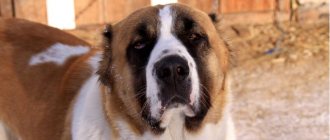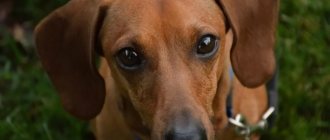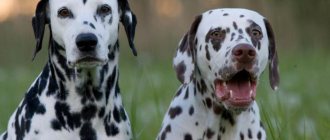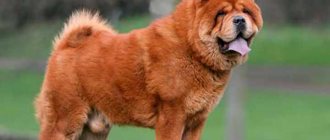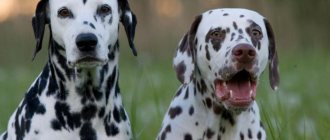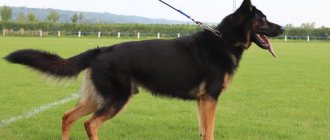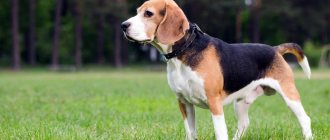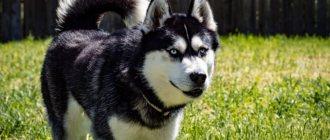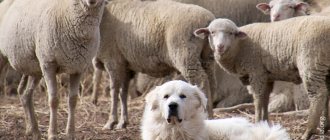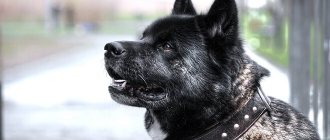One of the key signs of a horse that allows you to distinguish one breed from another is its color - a combination of the color of the animal’s hair with the color of its eyes and skin. This property is inherited and develops in the process of growing up: it is difficult to determine the color of a foal at birth. More confident conclusions can be drawn after the first molt (usually 7-8 months from the moment of its birth).
Horse colors with photographs and names are of interest to many lovers of these strong, hardy, strong and unpretentious animals.
What is a horse's color?
A horse's color is a simultaneous combination of the horse's skin color and the color of its hair. Determining a horse's color is also influenced separately by the color of its legs, tail and mane. Color is one of the main individual differences between a horse. It can be compared to the fur of livestock, the color of cats, or the coat of dogs.
Color depends on genetics and is inherited from parents. It is determined not by one color, but by their combination and geometric relationship. For example, with the same body color, the color may differ depending on the color of the mane. Among dozens of different suits, there are several central ones.
What are the main types of horse color? These include bay, red, black and gray. At the same time, there are only two main pigments - black and red. Mixing them gives black, bay or red color, and the process of early graying of horses gives gray color.
Which horse colors are considered derivatives? These are all other horses whose colors are formed by mixing base breeds at the genetic level or changing the color of individual parts of the body. Spotted suits also form on base suits. So from the red one came the game and nightingale colors, from the black one - ash-raven and tanned black, and from the bay - karak and dun. Suits can be formed on wild savras suits, such as mouse and kauraya.
The relationship between color and character
A person, relying on years of experience working with different animals, deduced the dependence of behavioral factors on the brightness of the coat, its main color. In different nations there are proverbs and sayings that define certain suits as the best for work.
Thus, the British believe: “Pale color is weakness of spirit.” And Arabian wisdom says that the hardiest and most obedient horses are bay, the gentle and beautiful are white, the weak are red, the wild and uncontrollable are black.
Hippology, a science that studies horses, speaks of the direct dependence of character, performance and health on color.
According to the classification of scientists, black and dark horses are considered the strongest and most durable. Lack of pigmentation (white spots) are the weak points of horses. The lighter the color, the less resistant the horse is to climate changes and harmful environmental influences.
Breeders build their theories on the dependence of temperament on color.
According to statistics, black horses are considered the hottest choleric people, and gray, yellow and golden horses are considered phlegmatic. Although coaches are confident that character is built on proper upbringing and heredity.
Voronaya
Black suit is a purely or predominantly black suit. Its description indicates a uniform black coloring of the head, body, limbs, mane and tail. Black color is found in most breeds. In some breeds, this color is the only possible color, for example, the Dutch Friesian horse. Other breeds, such as the Kladrub, have only two colors - black and gray. Black suit is a basic color and can be tested using a DNA test.
Although pure black does not provide for any color other than black, gray hair and tan are also distinguished. In the first case, the horse has white hair interspersed with it, which does not change color with age. In the case of tanning, ash-black hair at birth fades in the sun, its tips becoming reddish.
Black in tan - a type of black suit: Wikipedia
Redhead
This color is characterized by the red color of the body, tail and mane, while the shade of red horses can differ significantly from each other. Depending on the undertone, light red, dark red and brown colors are distinguished. The red color appears in almost all horse breeds, and such as the Don, Kabardian, Haflinger, Black Forest and Noriker horses have a unique red tint.
As with the black suit, one of the main suits, red, can be easily identified using a DNA test. At the same time, all possible shades of red color are tested as the basic red color, and there is no difference in the genotype of brown, light red, typically red or dark red at the genetic level. This test can be useful to separate dark brown horses from black horses.
Breeding
Depending on what goals the breeder pursues, there are several possible crossing methods:
- Purebred crossing. Involves the mating of animals of the same breed. It is used to strengthen the breed of breeding horses.
- Linear crossing. Involves the mating of horses of the same kind. A mare that is used for breeding is called a broodmare. This method is suitable when you need to improve the characteristics of the genus.
Linear crossing is divided into two more methods (homogeneous crossing - within the same genus or heterogeneous crossing, which implies that the mare and horse will come from different genera of the same breed).
Inbreeding involves the mating of individuals who are closely related (for example, brother and sister). However, most often they take animals that have a common ancestor no closer than in the third generation.
This is due to the fact that even when crossing animals that are related in the second generation, foals are born very weak and with genetic abnormalities.
The industrial method is used to produce work horses. The criteria of speed, beauty and thoroughbred are not taken into account.
To get healthy and beautiful offspring, you must adhere to several rules:
- The horse and horses must be healthy (without genetic abnormalities). At the time of mating they should not have any diseases.
- The weight of the animals is of great importance. If the mare is heavier than the horse, the foal will turn out to be low and small. If the horse weighs more than the mare, then the foal will take only the best qualities from its parents.
- Most often, animals are selected so that they are of the same height.
- The main criterion from which to proceed when selecting individuals for mating is the goal pursued by the breeder (need a foal for riding and performing, a workhorse or a breeding horse).
- A month before mating is planned, special vitamins are added to the horse and mare’s feed.
Direct insemination of a horse can occur in two ways: artificial and natural. The artificial method is used if it was not possible to inseminate the horse naturally.
There are 3 options for artificial insemination:
- Fresh. It is considered the most effective, but this option is completely unsuitable for transportation. It is recommended to carry out this operation in the same stable where the stallion stands.
- Frozen. The most expensive way. The horse material is frozen using liquid nitrogen and delivered to the desired corner of the earth. The material retains its properties for 30 years.
- Chilled. It is used when the horse and mare are in different stables. The material of the horse retains its properties for 30 hours.
However, there are a number of males whose material loses its properties when frozen.
The natural method also implies several options for insemination.
- Pasture. It consists in creating a herd of horses of 12-15 heads (among which there is a dominant mare) for a stud horse. During the period of sexual activity, a horse is capable of impregnating 3-4 mares per day. With this method, the vast majority of mares from the herd are fertilized in a short period of time.
- Varkovy. It is used when it is necessary to cover a violent, obstinate mare. The entire procedure takes place under the supervision of a special trainer, who prompts and teaches the horse how to cover the mare. This method is extremely rarely used, as there is a risk of injury and sexually transmitted infections.
The gestation period of mares ranges from 11 to 12 months. During this time, the mare is relieved of heavy loads and is not ridden. Vitamin supplements are added to the diet.
If there were no complications during pregnancy, then labor takes place quickly (about 2 hours).
Igrenovaya
The game color includes horses that have a red body color from light red to chocolate. The color of the mane and tail of these horses is white. The legs are pure tan or have white markings. The game color should not be confused with the illuminated red color. There are breeds that are characterized by a playful color: the Haflinger, the American Belgian breed and a rare breed of draft horses - the Black Forest horse.
Game suit: Wikipedia
Famous "bays"
Old Billy
Bay horses are regular participants in various sports competitions and races, they win first places and often become record winners, whose names fit into the “horse” history:
- Thus, the longest-living record holder is a gelding named Billy. While the average horse lives 25 years, he lived a whopping 62 years. And his life was not strewn with roses, all his life from birth to death, he towed a barge along the coast.
- Vulcan is a heavy truck, which back in 1924 was able to carry luggage weighing 29.5 tons.
- The dark bay horse Nearco is the progenitor of many champions who annually win prestigious competitions.
- Picolo Ribot is an Italian horse who has never known what losing is, since he has only winnings in his piggy bank. He managed to reach the finish line, ahead of his rivals by several lengths.
Picolo Ribot
- The best English riding horse that has been officially recognized is Frankel. It was valued at a record $200 million.
- An elegant and beautiful horse, Poetin , with a tragic fate, received from fans the nickname “Ballerina” and the more prosaic nickname “Million Dollar Baby.” She has shone since 2000 at various conformation competitions, where she was always among the favorites, and in competitions the judges rated her gallop, trot and walk very highly, often giving her the maximum score.
bay
The bay color has a red or brown color to the body, neck and head. However, the lower part of the legs from hoof to hock, mane and tail are black. There are black hairs on the body that mix with the overall red color. Unlike the red or black base color, bay horses have both red and black pigment in their coat and hair. At the same time, black and red colors are clearly distinguishable. As a base color, bay color is easily identified by a DNA test for the presence of a special Agouti gene.
This is one of the most common horse colors. It is quite common among breeds, such as the Arabian, Thoroughbred Saddlebred, Russian Trotter, Oryol Trotter, and for some, the only one (Cleveland Bay Trotter). Often found in mongrel horses.
Basic colors
Bay color
The bay color of the horse is considered the most common. For many peoples, over the centuries, these horses were considered the best, with excellent working qualities. Perhaps the wild ancestors of modern domestic horses were bays. Now geneticists have refuted the connection between bay color and physical characteristics, but the ancient tradition continues to live, and many horse breeders prefer bay horses. They are often taken to races, sporting events, and used as draft work horses.
Descriptions of the bay color of the horse are found in many sources. Its body color is brown. The hair on the mane and tail is black. The legs below are also black. There is a wild version of the bay color; in such horses, black hair on the legs is mixed with brown. Young hinnies have completely light-colored legs; they darken only a couple of months after birth. Bay horses have certain color variations; they have their own underlays or underlays.
Here are the bay colors of horses and a list of their varieties:
- Light bay. The fur on the face, tummy and around the eyes is light brown. Individual brown hairs are visible on the mane and tail, as well as on the lower legs. A dark stripe or a kind of “belt” may run along the spine, and the legs may have a pattern reminiscent of a zebra’s coloring.
- Dark bay. Such horses have a dark, almost black, upper part of the head, neck in the crest area, the space above the shoulder blades, back and croup. The remaining parts of the body may be a little lighter. Often in these places the fur is reddish.
- Podlasaya. The main tone is brown, there are light spots near the mouth and eyes, in the groin area, and in some individuals - on the elbows and buttocks.
- Bay deer. Such horses have a dark back, as do the shoulder blades and croup. The neck along the scallop and the head on top are also dark; the side surfaces of the body are lighter than the back, but darker than the muzzle, throat and belly.
- Chestnut. The horse's body is the color of a dark chestnut, the legs below, as well as the mane and tail are black.
- Cherry. The color of the horse's coat is red-brown or red-red. Brown hairs are visible on the legs. The cherry horse is almost red, with a beautiful tint of ripe cherry.
- Golden or golden. Quite a rare horse color, which is now highly valued. The tone of the fur is yellow-brown, richly shimmering with gold.
- Karakova. This color is an intermediate option between bay and black. The Karak horse looks almost black. It clearly shows light brown markings on the tip of the muzzle, near the eyes, in the armpits and groin. They contrast beautifully with the main dark background of the fur.
Black horse
- Origin of the cat
- Hypoallergenic dogs
- Fighting dog breeds
- The rarest cat breeds
- German Shepherd
- What kind of snakes are kept at home?
The black horse breed is one of the most famous and popular throughout the world. The incredibly beautiful shimmer of blue emphasizes the nobility and prestige of horses of this species. Such splendor can be achieved only with proper care: good nutrition, daily walking, cleaning and bathing with special products, combing.
The name “crow” speaks for itself. This type is characterized by a jet black color (like a raven's feather) throughout the body, tail, mane and head. Small areas with brown hairs are allowed. They usually appear due to sunburn. Mares are allowed to have a small white mark. A black horse begins to shed when the weather changes frequently. Therefore, sometimes you can find a color with spots.
There are 3 types of black suit:
- black shade with blue tint;
- black shade with chestnut tint;
- brown color, bleached by the sun.
The black horse attracts with its dazzling brilliance, grace and grandeur. Mention of this color of horses is often found in literature, works of art and films.
Redhead
All the nuances of red give rise to numerous colors of horses. In this case, the distribution of pigment is necessarily continuous, albeit of different saturation or intensity. Lighter or darker hair color options in the mane and tail are acceptable. The legs are distinguished from bays. They are usually completely identical to the main shade. The red color is multifaceted - from lightened apricot to rich chestnut.
The main thing is the presence of warm, golden shades:
- The most saturated gives a brown color. These horses can easily be confused with bays. In fact, they are dark brown, but, unlike the latter, their coloring is uniform. The legs match the color of the body.
- The game color is distinguished by a sharp contrast: the body is usually colored red to brown, and the mane and tail are very light, smoky or milky white. It does not change during the year and does not fade in the sun.
- The nightingale color is less contrasting than the game color. The body is all shades of yellow, shimmering with gold. And the tail hair and manes are whitish or yellowish. The nightingale horse is often similar in body color to the dun horse, differing in the contrast of its manes and tails.
- The horse's Isabella color makes the most lasting impression. The combination of creamy hairs and pink skin creates an indescribable effect called baked milk. Isabella horses, in addition to everything, have angelic light eyes (gray or blue).
Genetically, the nightingale, rare isabella or dun horses are very close to each other, so these colors are often found as a characteristic feature in any breed.
Gray
The animal acquires a gray coloration of its skin with age. Newborn foals do not have a smoky coat. The tone is distinguished by several color variations: from white vanilla to dark gray. In the 4th year of life, the animal becomes whitish-gray; in the 9th year of life, the horse completely turns grey. First of all, the animal's abdomen and head area changes color. The darkish cover remains on the body and legs for a long time.
Shades of gray and color features directly depend on the underlay. List of those meeting:
- Apple gray. There are grayish “apples” against a dark background.
- Dark grey. This shade is mainly found in young stallions. Some individuals retain a darkish gray color until old age. The horse's body is much lighter than its head. The tail, mane and limbs are in most cases dark in color, less often gray-brown.
- Light grey. The boiling white individual also belongs to the light gray subfloor. The light gray stallion becomes white with age.
- Buckwheat gray. Almost white horses, often “decorated” with small dotted spots of a darkish color.
Pure white horses are extremely rare in nature; spotted horses are more common. A white horse differs from a light gray horse in the shade of its skin. The number of white areas on the skin increases significantly before molting.
Karakova
Horses of karak color have a black color of the head, body, legs, mane and tail, but there are also characteristic “tan marks” of a red color. They are located at the end of the snout, legs and groin. Only the horse that has bright and clearly distinguishable “tan marks” of red color can be classified as karak color. If they are brown or close to black in color, the color is considered bay.
Karak is a special shade of bay that is DNA tested in the same way as a horse's base bay color. Most often, the karak color is found among the Kabardian and Karachay breeds.
Bulanaya
The dun horse has a sandy-yellow body color, black mane, tail and lower legs. The eyes of horses of this color should be brown or amber. Shades of body color vary from almost white sand to dirty yellow. The lower part of the legs may not be pure black, but with a brown tint. On the spine of dun horses you can often see a black stripe - a “strap”.
The dun color is a derivative of the bay color. It arose due to the influence of the horse pigment illuminator gene. The color is typical for Akhal-Teke horses.
Isabella
Isabella color has the color of baked milk or beige. The tail and mane can have the same color as the body, be lighter or darker. Horses of this color have pink skin, often with freckles, and blue eyes.
At one time, Isabella color was thought to be white or caused by albinism, but this is not the case. In fact, this suit is a derivative of all three basic suits with a double set of the pigment illuminator gene, which is confirmed by the research of Denis Mariat. Isabella color can be seen more often in Akhal-Teke, thoroughbred riding, Tory, Irish draft, Belarusian draft, many breeds of ponies and mongrel horses.
Gray
The gray color is formed due to the early graying of any of the possible colors. Because of this, it is very common. Animals begin to turn gray at different times, sometimes even before birth. Gray horses are usually born hyperpigmented, with a pronounced presence of pigment in the coat and hair.
The gray coat retains the color of the eyes, skin and hoof horn, only the base color of the hair changes. The shades of the gray horse are very diverse, from light gray to pink and red-gray. Gray horses with apple or buckwheat patterns are often found. Gray horses are found in almost all breeds.
Buckwheat gray: Wikipedia
Content
All worries about keeping horses come down to arranging the stable and feeding. The room allocated for the stable must be dry and warm.
It should not be exposed to drafts. The floor of the stall is covered with hay. The stall must have a window, a feeder for dry food and a container for water.
Horses are fed small portions 4-6 times a day. The horse should not be loaded an hour before feeding and an hour after it.
A horse's diet may include hay, grass, haylage (it differs from hay in the way it is prepared, due to which it contains more water), vegetables and fruits, grain and bran. One horse requires 40 liters of water per day.
Particular attention should be paid to the harness. It should be quite comfortable, not rub anywhere or cause discomfort to the horse.
Roan
Roan color is characterized by a uniform admixture of white hair based on any color. Moreover, the darker the horse, the more noticeable the contrast between the white and the base color. Predominantly white hair is distributed throughout the horse's body, but can also be found in the mane or tail. Roan suits vary depending on the color of the main suit. For example, the raven roan has white hair on the body with a black tail and mane. Roans are found among mustangs, Soviet and New Alexandrian feathers.
Savrasaya
Savras color is the oldest horse color. Because of this, it is also called wild. Thanks to the special colors, owners of the savras suit can camouflage well. A number of “wild markings” help horses do this. They form different dark patterns on the animal's body: a belt on the back, a web on the forehead, a mask on the face or frost on the tail.
Savras color is present in many breeds: Bashkir, Vyatka, mustangs, Polish skates, Belarusian draft horses and American quarter horses. In artificially bred breeds, for example the Trakehner, the savras color is not found. Since the ancient ancestors of horses had the savras color, it can easily be analyzed through a DNA test.
Lifespan
The lifespan of a horse depends on the conditions of its existence, area and load. Wild individuals rarely live more than 10 years, as they have to fight for survival throughout their lives. Climatic conditions, infections, and predators significantly shorten the life of wild individuals.
Horses live much longer at home, up to 30 years. Breeding stallions have the longest life up to 30 years, as the breeder pays special attention to them. Sports horses live up to 20 years. Even working horses, provided they are well maintained and have the correct alternation of work and rest, can live up to 25 years.
Mousey
The mouse suit is formed by the savras suit on the black suit. Such horses have a gray or dirty gray body color, a black mane and tail, and often have a black head and legs. "Wild markings" are also black in color and are clearly visible. Unlike gray horses, which have a mixture of white and gray hairs, the hair of murine horses is gray on its own. It is common among Sorraya horses and among Polish skates.
Mouse color of horses: Pxfuel
Piebald
Pinto horses have large, irregularly shaped spots scattered throughout the body, mane and tail. By their color on the horse's body, you can determine the base color of the animal. On this basis, raven-piebald, bay-piebald, red-piebald and other colors are distinguished. The most common type of piebald is colorful. It is characterized by large colored spots on a white background, usually oval in outline. From a genetic point of view, all piebald colors are distinguishable and belong to different base colors, but for convenience they were combined into one.
Artiodactyl habitat
The ancestors of today's horses lived throughout Eurasia and northern Africa. Later in the Ice Age they lived in North America, but became extinct about 10 thousand years ago. Scientists believe that horses are the only genus of the equine family of the artiodactyl order that has survived to this day.
In some regions, you can still find herds of horses living in the wild today. Domesticated species are distributed throughout the world; they are represented by a huge number of breeds that differ in build, size, head shape, color and other characteristics.
The preferred habitat for horses is cool temperate climates with grasslands, steppes and savannas. Some species can live in semi-deserts, as well as among forests and swampy areas. When domesticated, horses can adapt to different places and climates.
Chubaraya
Another spotted color is Chubara. Such horses have spots of different colors densely scattered across their white body. Depending on the location on the body and the shape of the spots, more than ten types of forelock are distinguished, for example chaprak, leopard, speckled, snowflake and others.
Although the forelock color is one of the most ancient (horses are depicted in cave paintings from Paleolithic times), now this color is extremely rare. It happens in the Appaloosa, Knabstrupper, Noriker, Altai and Yakut horse breeds.
Chubby leopard-type horse: Wikipedia
Interesting Facts
The Isabella suit, like any other, has a number of its own individual characteristics. Let's consider each of its features separately:
- Such horses are very rare, they are even considered one of the rarest breeds in the whole world. Usually you can only find them among true connoisseurs. What this is connected with is not particularly clear, most likely this is because the beauty of the Isabella color is endowed with a slightly frightening albino beauty and many, out of habit, are even afraid to have one.
- The second name for the Isabella horse is the cream horse. The breed owes this name to its soft cream coat color.
- In addition to the unique color, what makes such a horse unusual is the presence of shine. Moreover, this shine is visible not only in person, but also noticeable through photography. For those who have not seen a horse in person, when looking at its image, it may seem that some kind of effect has been imposed on it.
- In order to breed a purebred Isabella horse, you need to combine two completely identical genes.
- In America, the term “cremello” is used to refer to these amazing horses.
- Although outwardly such a horse looks thin, delicate and even fragile, in fact it has considerable strength and incredible endurance. It doesn’t matter to her what natural conditions to live in. The strength of the Isabella horse was also praised in legends, one of which states that during the war such a horse could carry up to three wounded people across the sands at a time. It equally endures cold of -30 degrees and heat of +50.
- Thanks to the high canter and stride, the horse can move without problems in quicksand conditions.
- The Isabella horse is very expensive because it has two red ancestors in its family; this combination is extremely rare.
White-born
Typically, a horse with a pure white coat will be light gray or light Isabella. However, the white color of horses does exist, although it is extremely rare. White-born horses, contrary to popular belief, are not albino. They have pink skin, dark eyes and white fur.
Beautiful animals come in a dozen colors. It never hurts to demonstrate your horizons and name the correct color of the animal.
Original article: https://www.nur.kz/household/pets/1941959-masti-loshadey-foto-opisaniya-i-nazvaniya/


